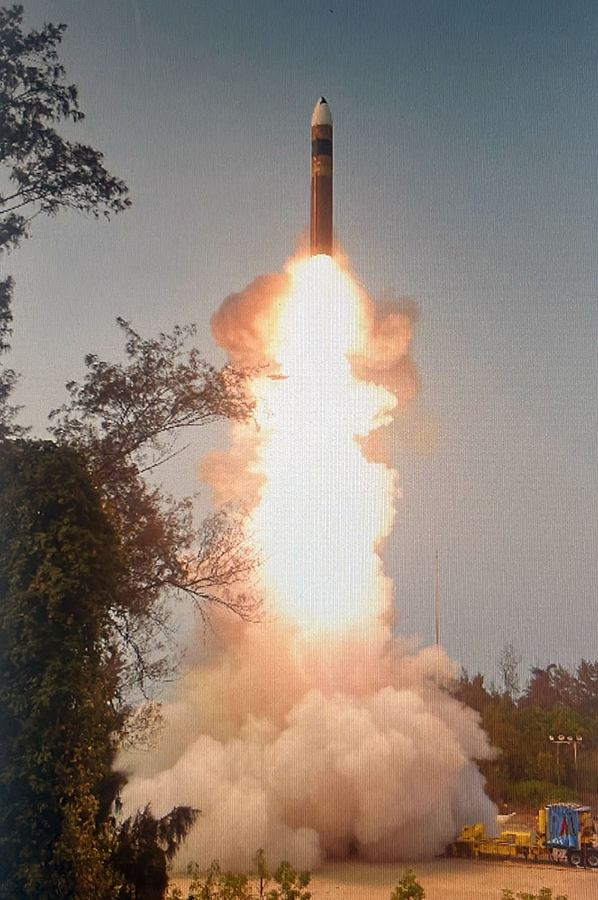"I find hope in the work of long-established groups such as the Arms Control Association...[and] I find hope in younger anti-nuclear activists and the movement around the world to formally ban the bomb."
Indian Missile Capable of Firing Multiple Warheads
April 2024
By Shizuka Kuramitsu
India announced what it called a successful test of the country’s first domestically produced missile carrying multiple warheads with independent targeting capability, thus signaling progress in advancing a nuclear deterrent against China.
 In a social media post on March 11, Indian Prime Minister Narendra Modi commended efforts by the national Defence Research and Development Organisation (DRDO). “Proud of our DRDO scientists for Mission Divyastra the first flight test of indigenously developed Agni-5 missile with Multiple Independently Targetable Re-entry Vehicle (MIRV) technology,” Modi wrote.
In a social media post on March 11, Indian Prime Minister Narendra Modi commended efforts by the national Defence Research and Development Organisation (DRDO). “Proud of our DRDO scientists for Mission Divyastra the first flight test of indigenously developed Agni-5 missile with Multiple Independently Targetable Re-entry Vehicle (MIRV) technology,” Modi wrote.
The organization released a press release on the same day stating that the test was carried out from Dr. APJ Abdul Kalam Island in Odisha and that “[v]arious [t]elemetry radar stations tracked and monitored multiple re-entry vehicles.” The agency added that “[t]he mission accomplished the designed parameters.”
With the test on March 11, months before Modi faces a national election that could give him a rare consecutive third term in office, India joined a short list of states that are confirmed to possess operational missiles with MIRV capability: China, France, Russia, the United Kingdom, and the United States.
“While the Indian government may rejoice in its technical achievement, the proliferation of MIRV capability is a sign of a larger worrisome trend in worldwide nuclear arsenals that is already showing signs of an emerging nuclear arms race with more destabilizing MIRVed missiles,” Hans Kristensen and Matt Korda of the Federation of American Scientists wrote on their organization’s website on March 12.
“The capability to deploy multiple warheads on each missile is one of the most dangerous developments of the nuclear era because it is one of the quickest ways for nuclear-armed states to significantly increase their number of deployed warheads and develop the capability to rapidly destroy large numbers of targets,” they said.
One day later, in an interview with Fortune India, Kristensen added that “[a]lthough there are still technical challenges before MIRV [capability] becomes fully operational in India, Pakistan, and North Korea, the trend is that the MIRV club has doubled in the past decade.”
Developed in the early 1960s and operationalized in the 1970s by the United States and the Soviet Union, MIRV technology impacted the strategic calculus of deterrence by enabling a single missile to carry multiple warheads that each can hit separate targets.
This capability increases the effectiveness of an attack, making it more difficult for adversaries to defend against multiple warheads or decoys. From an adversary’s perspective, land-based missiles equipped with MIRV technology would be a prime target before their launch because they offer a chance to destroy multiple warheads at once.
Although the development and deployment of MIRV technology increases the proficiency of a first strike, it also can destabilize deterrence calculations and raise concerns about an accelerating arms race and the potential for rapid nuclear escalation.
Because Indian missiles already can reach all of Pakistan, analysts generally agree that India’s focus on expanding its MIRV capability, developing longer-range missiles and hypersonic weapons, launching an integrated rocket force, and advancing missile defense systems on land and sea is intended to deter China. (See ACT, December 2021.)
The Agni-5 missile has an expected delivery range of more than 5,000 kilometers and can strike most of China, according to the Center for Strategic and International Studies Missile Defense Project. In recent years, a significant weight reduction enabled the missile to travel distances beyond 7,000 kilometers, Indian defense officials told India Today TV on Dec. 17, 2022.
India has invested in MIRV capability for more than a decade. (See ACT, October 2018.)
Pakistan also has been developing MIRV technology “to increase stability and deterrence by increasing the chances of penetrating of India’s emergent ballistic missile defenses,” according to an article published by the International Institute for Strategic Studies in November, but the result of its latest missile test, in October, was described as unclear.
Reflecting on the latest Indian test, the U.S. State Department on March 12 told the Indian news outlet ANI that “[t]he United States and India share a vision for an Indo-Pacific region that is free, open, secure, and prosperous. We continue to work as partners with India and with other countries in the region to achieve this vision.”
Meanwhile, in a statement delivered at the Conference on Disarmament on March 14, Anupam Ray, the Indian ambassador to the conference, reaffirmed India’s doctrine of minimum credible deterrence and, as part of it, no first use of nuclear weapons. “India has espoused the policy of no first use against nuclear-weapon states and nonuse against non-nuclear-weapon states. We are prepared to convert these undertakings into multilateral legal arrangements,” he said.
